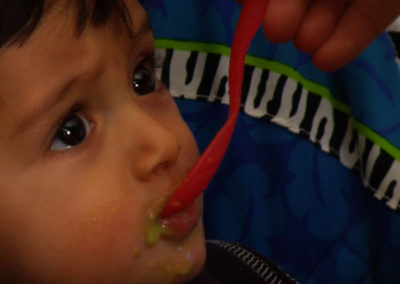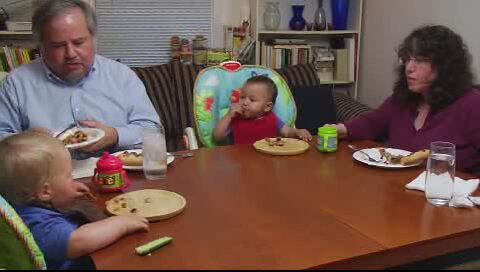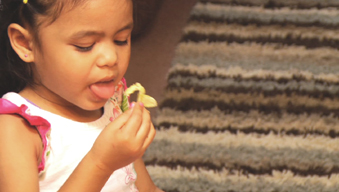
Child feeding ages and stages
On this page
- Birth to 3 months: Feeding your newborn
- 2 to 6 months: Feeding your infant
- 5 to 9 months: Feeding your older baby
- 7 to 15 months: Feeding your almost-toddler
- 11 to 36 months: Feeding your toddler
- 3 to 6 years: Feeding your preschooler
- 6 to 12 years: Feeding your school-age child
- 12 to 17 years: Feeding your adolescent

Birth to 3 Months
Feeding Your Newborn
Help your newborn be calm and stay awake
Your newborn comes out of a quiet, dark place into a world full of sights, sounds and commotion. To do well with eating, she needs help being calm and staying awake. To help her, feed her the way she wants you to.
Do what your baby wants with feeding
Don’t worry about spoiling her. You can’t spoil a tiny baby.
- Pay attention to her cues and feed her when she wants to eat, when she is wide-awake and calm and before she gets upset from crying.
- Sit still during feeding. Keep the feeding smooth and steady.
- Let her eat her way – much or little, fast or slowly, steady or start-and-stop.
- Stop feeding her when she shows you she is finished eating. She will relax, slow down and stop nursing.
- Talk or play awhile after feeding. Put her to bed when she’s calm and drowsy and let her put herself to sleep.
Your baby knows how much to eat
Your baby will eat as much as she needs and grow in the way that is right for her if you maintain a division of responsibility in feeding.You are responsible for the what of feeding – breastmilk or formula. Your baby is responsible for everything else – when, where, how much, how fast.

2 to 6 Months
Feeding Your Infant
When your baby is 2 or 3 months old, he begins to learn about love. He watches, smiles, jabbers, and reaches out to get your attention and to keep you close. Your paying attention to him and doing what he wants shows him you love him and teaches him to love you back. Don’t worry about spoiling him. You can’t spoil a tiny baby.
Follow the division of responsibility in feeding
You are responsible for the what of feeding – breastmilk or formula. Your baby is responsible for everything else – when, where, how much, how fast.
Guide feeding based on your baby’s cues
Feed on demand: Go by information coming from your baby to guide feeding
- Feed your baby when he wants to eat, when he is wide-awake and calm.
- Let him eat his way – much or little, fast or slowly, steady or start-and-stop.
- Bring him to the table with you when you eat. He loves being with you, and he begins learning what eating is all about.
- Talk or play awhile after feeding. Put him to bed when he’s calm and drowsy and let him put himself to sleep.
Wait to start solids
Start solids based on what your baby can do, not on how old he is: when he can sit up, see food coming, and open up for it. That is around six months for most babies.
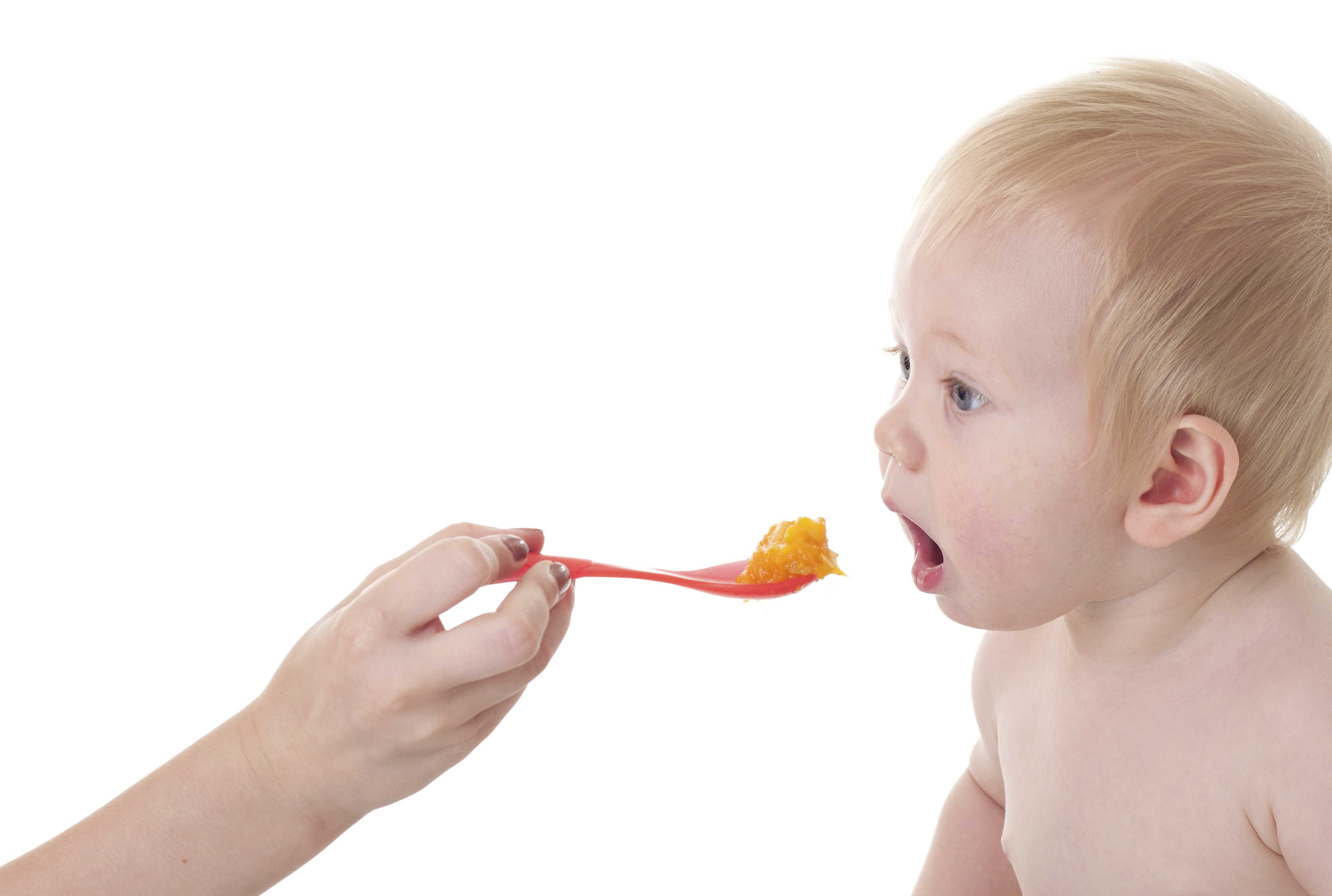
5 to 9 Months
Feeding Your Older Baby
Your older baby’s learning to eat solid foods goes along with her interest in the world. She watches you eat, and she wants to eat, too. Go by what your baby can do, not by how old she is to guide starting and progressing solid foods. Then let her do it her way. One baby will accept solid foods from the start, quickly learn to close her lips over the spoon and swallow, accept thicker, lumpier food, and be ready by 7 to 10 months to finger-feed herself modified family food at family meals. Another cautiously accepts solids but needs to be introduced gradually to a variety of tastes and textures and get to family meals when she is in her second or even third year. Another takes to the spoon readily and demands to feed herself—even though she can’t! Still another isn’t at all interested in the spoon, and waits to eat solid foods until she can finger-feed herself family food.
Start solids based on what your baby can do
This point is NOT to get food into your baby. She is getting plenty of nourishment from her breastmilk or formula. It is to introduce her to the notion of eating different food, in a different way. Stow your agenda, and don’t get pushy or you will spoil the fun for both of you! Your baby is ready to be introduced to solid foods when she can:
- Sit up
- Do something with the spoon. It is all learning and it is all part of growing up with eating.
- Open up for it, get the food into her mouth.
- Grab it and bang it.
- Drop it on the floor.
- Touch the food and smear it around.
How to introduce solid foods (provided your child is willing):
- Have her sit in a high chair looking straight ahead.
- Hold the spoon a few inches in front of her mouth and wait to see what she does.
- Do it her way: let her eat or not eat, eat little or much, fast or slow.
- Stop the feeding when she is done opening, swallowing, smearing, dropping, banging.
- Give her plenty of chances to learn, have fun, and keep it casual.
Move on to thicker and lumpier foods
You will help your baby to develop her mouth skills by offering her thicker and lumpier food and then pieces of soft family food at family meals. She will eat more regularly and at longer intervals, so feeding times are partly on demand and partly on a schedule that you determine. Feeding her will go best if you get started now with family meals.
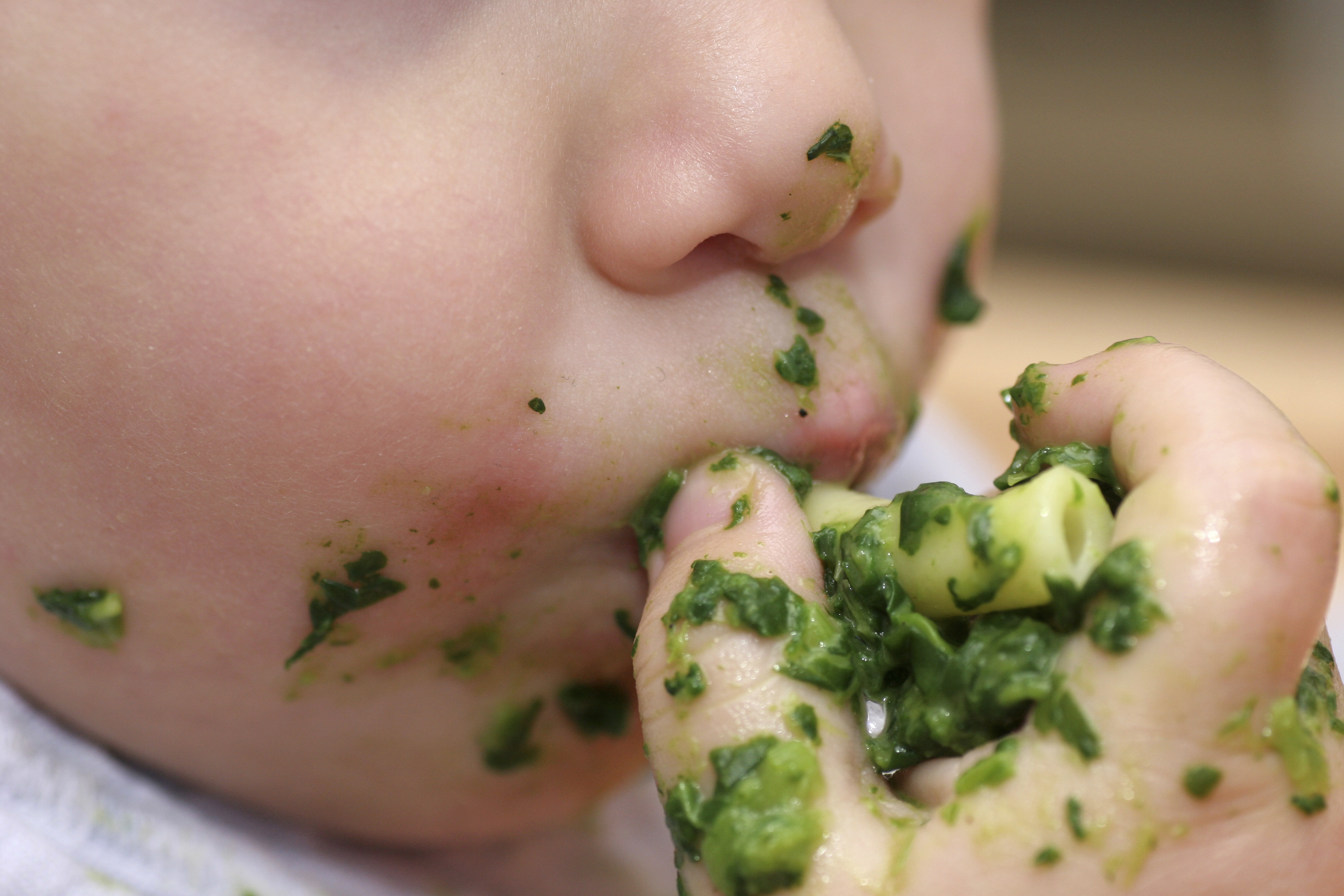
7 to 15 Months
Feeding Your Almost-Toddler
The almost-toddler – the child just getting started with finger-feeding – cares deeply about feeding himself and is enthusiastic about eating almost everything you put before him. The problem is that it happens so fast. One day he happily lets you feed him. The very next day – or the very next meal – he refuses the spoon, grabs at it, and puts up a fuss when you try to feed him. Many parents become alarmed and force or play games to get their child to eat. Don’t. His eating will be worse, not better, and you will introduce feeding struggles that can go on for years. Instead, let him feed himself. Get started with family meals, if you aren’t having them already, and eat with him, don’t just feed him.
Include your child in family meals
- Offer your child safe food to pick up, chew and swallow: soft or easily chewed table food. Be considerate without catering with meal-planning.
- Let him eat his way-fingers or spoon, much or little, fast or slowly, and in any order – even if he eats dessert first.
- Offer breastmilk or formula in a cup, not a bottle. He may have whole milk when he is eating family food at mealtime and is a year or more old.
- Give him about a tablespoon of each food. Let him eat or not. Let him have more if he wants.
- Give him lots of chances to try new food and learn to like it.
- Let him get down when he finishes – even after just a few minutes.
Get started with sit-down snacks
During the older baby stage, in response to your child’s increased regularity with feeding, you offered snacks partly on demand and partly on a schedule that you determined. At the almost-toddler stage, you continue to support his transition from demand feeding to structure by offering your child sit-down snacks roughly every two or three hours between meals. That lets him arrive at mealtime hungry (but not starved) and therefore able to behave nicely: He is interested in eating the food there. While he is likely to love drinking and eating on the go, he won’t learn to eat the food you eat because his special food, delivered in his special way, is more to his liking. Offer any nipple-feedings (breastmilk or formula) as a structured, sit-down snack. Don’t offer anything else between times except water. You are establishing the meals-plus-snacks routine of the division of responsibility for older children: Parents do the what, when and where of feeding, children do the how much and whether of eating.
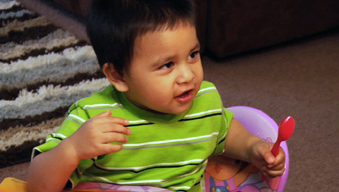
11 to 36 Months
Feeding Your Toddler
After eating enthusiastically as an almost-toddler, your toddler’s eating will suddenly become cautious, erratic, picky, and fickle. Many times, she will only eat a few tastes, swallows, finger-fulls, or bites. Other times, she will eat more than you can imagine. Do not try in any way to get her to eat. Instead, give her both clear leadership and a sense of control.
- Get started with family meals, if you aren’t having them already.
- Give leadership by offering foods you choose, at sit-down meals and snacks, at regular and reliable times.
- At meals and snacks let her decide how much and even whether she eats from foods you have put on the table.
- Keep yourself comfortable by understanding her normal, erratic, eating behavior.
- Let her get down from the table when she loses interest in eating and/or starts to misbehave. Tell her, “Once you get down, you can’t come back.”
- Teach her to play quietly while you finish eating.
Don’t teach eating for emotional reasons
Your toddler is at high risk for learning to use food for emotional reasons. Toddlers are active, unceasing in their demands and prone to get upset. It is tempting to give food to quell the riot. Don’t. Instead, stick to scheduled feedings and sort out whether your child is hungry or sad, full or tired. Give attention, discipline, hugs or naps.
Maintain the quality of your feeding relationship
- Get your focus off what your child eats and on to how your child feels and behaves at family meals.
- Have 3 meals a day at set times and eat with her – don’t just feed her. Offer her sit-down snacks every 2 to 3 hours between times.
- Be considerate without catering with meal-planning. Include 1 or 2 foods she generally eats along with other mealtime food.
- She will be skeptical even of food she has eaten enthusiastically before, but do not short-order cook or limit the menu to foods she readily accepts. Instead, be considerate without catering in your meal-planning.
- Let her eat her way – fingers or utensils, fast or slow, much or little, 1 or 2 foods, and in any order – even if she eats dessert first.
- Say no when she begs for food or drinks between times, except for water.
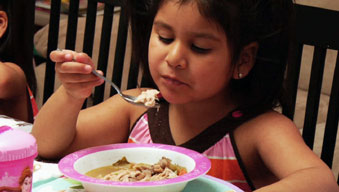
3 to 6 Years
Feeding Your Preschooler
Compared with feeding the toddler, feeding the preschooler is easy. Your preschooler is playful and quirky and wants to please you in all ways – including eating. But in some ways, that makes feeding harder. You can get your preschooler to eat more, less, or different foods than he wants. You can keep after him about table manners, even though it is still natural for him to use his fingers along with his silverware. But if you do, it will make him feel bad about eating. He won’t enjoy learning to eat the foods you eat. He will stop being able to eat as much as he is hungry forl. He will, that is, provided he is a compliant child. If he is not so compliant, he will fight back and feeding will become a battle ground. Stow your agendas, make meals with food you enjoy, eat with him, and follow the division of responsibility in feeding. Then trust your preschooler manage his own eating.
- Have 3 meals a day at set times and sit-down snacks at more-or-less set times. Say no to between-times food and beverage grazing – except for water.
- Sit down and eat with him, don’t just feed him. Be good company.
- Be family-friendly in your meal-planning by being considerate without catering. Put together meals that allow everyone to be successful.
- Let him serve himself and eat his way – fast or slow, much or little, 1 or 2 foods. Let him eat in any order, even if he eats dessert first.
- Let him have more of any food (except dessert), even if he hasn’t cleaned his plate.Excuse him when he is done.
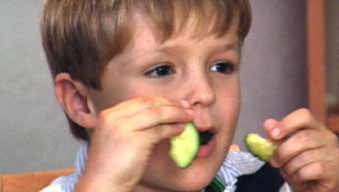
6 to 12 Years
Feeding Your School-age Child
Your school-age child is full of contradictions. She wants to master all things – including eating, but she is still a child, and is entitled to be free from worry about eating, moving, and weight. She seems independent, but she depends on you to keep control of the family menu and continues to need the structure and support of regular family meals and structured snacks.
Continue to follow the division of responsibility in feeding
- Do your jobs with feeding, and let your child do hers with eating.
- Arrange for your child to have 3 family-friendly meals a day at set times.
- Let her eat her way-fast or slowly, much or little, some of everything or 1 or 2 foods.
- Let her eat in any order, even if she eats dessert first.
- Let her have more of any food, even if she hasn’t cleaned her plate.
- Say no to between-times food and beverage grazing-except for water.
Exert your authority on after-school snacking
- Make rules, then expect her to go by the rules. The rules are about structure.
- Teach her strategies for putting together a good-tasting and satisfying snack.
- Snack right after school and at the table. No munching along with homework or in front of the TV.
- After she learns to go by the rules and apply the strategies, let your older school-age child choose her own snack, even if it is forbidden food – high fat, high sugar.
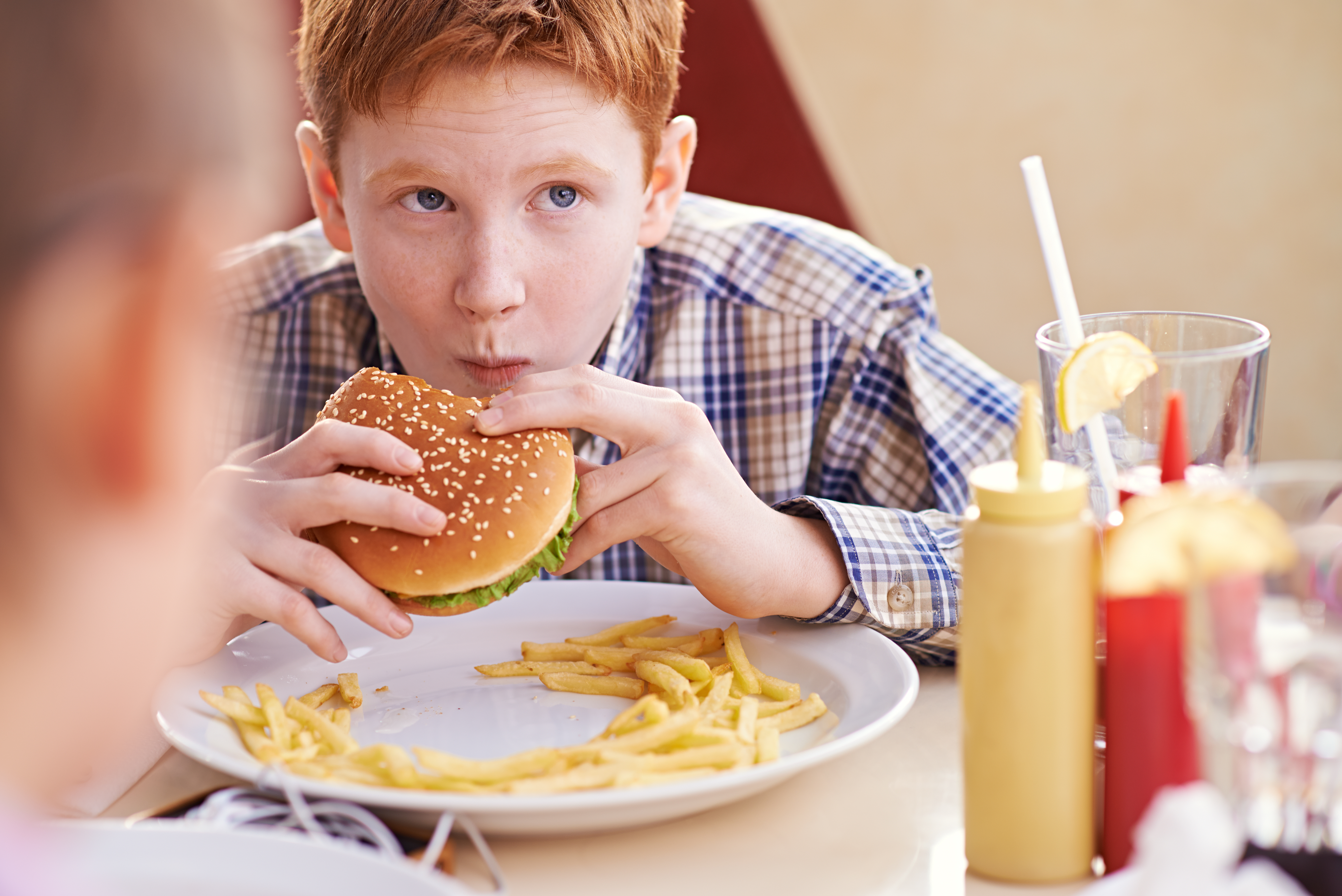
12 to 17 Years
Feeding Your Adolescent
Despite his acting like it doesn’t matter, your adolescent continues to depend on you to maintain the structure of family meals. He will participate in family meals when you make meals a priority, keep mealtimes pleasant and use mealtimes for connecting. Adolescents who have family meals do better in all ways, and they do better nutritionally after they leave home. With feeding as with all other things, your task is to find the middle ground between being controlling on the one hand and throwing away all controls on the other.
Continue to follow the division of responsibility in feeding
- Doing your jobs with feeding and letting your child do his with eating guides you in knowing when to take leadership and when to let go.
- Expect your child to manage his schedule and his snacking so he can arrive at dinner on time and hungry.
- Teach him to take responsibility for eating 3 meals a day and a snack right after school.
- Let him find his own ways with food away from home: what to eat, how much to eat, how to get what he needs.
- Discuss his food-management strategies with him; consider what works and what doesn’t.
- Build your child’s food-management skills for after he leaves home: meal planning, food preparation, shopping, storage, sanitation.







